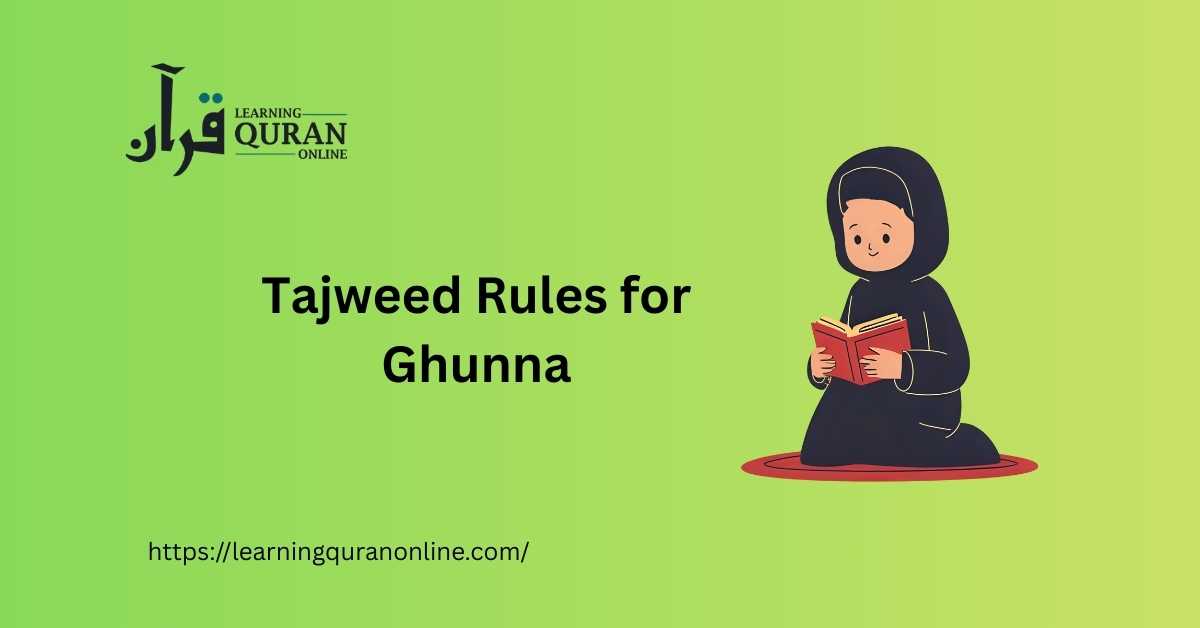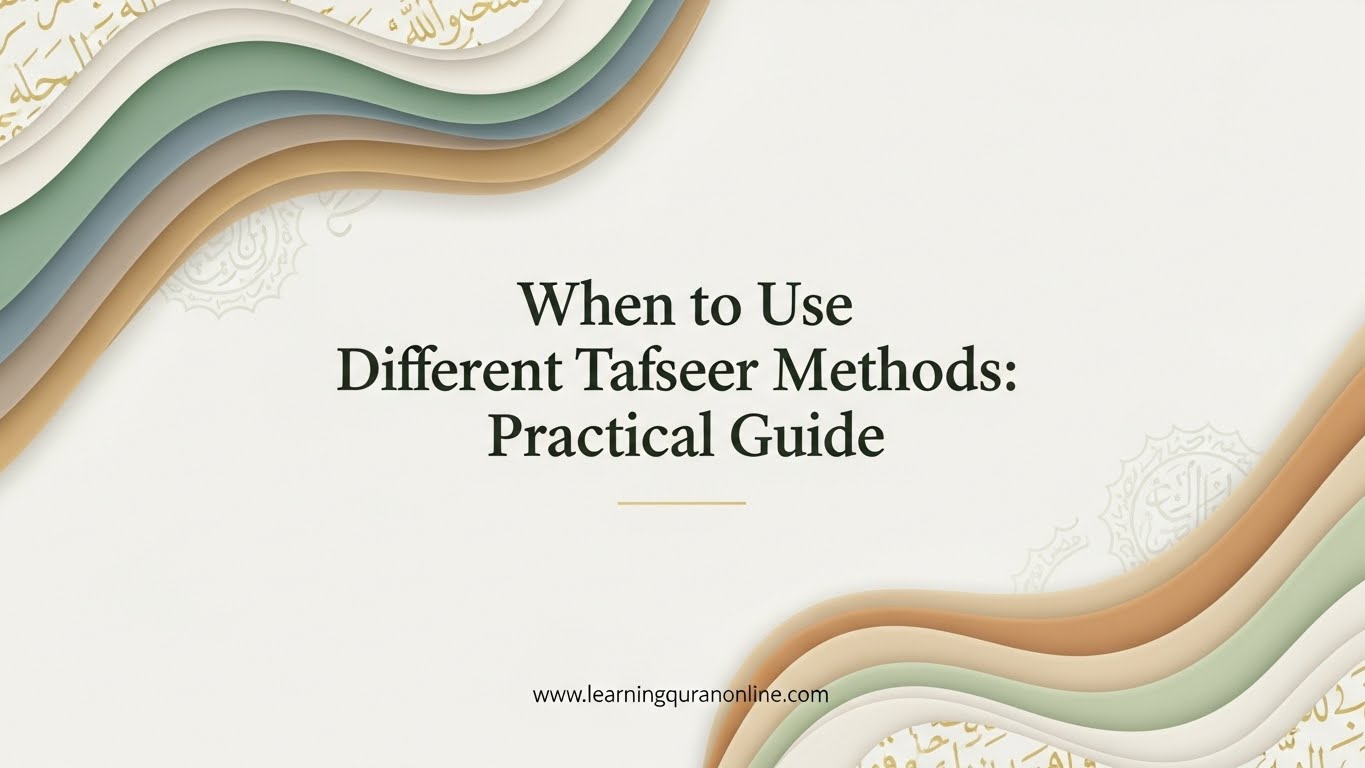Table of Contents
ToggleWhat is Ghunnah?
Ghunnah (غنة) literally means “a nasal sound.” In Tajweed it refers to a controlled nasal resonance produced when certain letters are held for a short time (usually two counts). Ghunnah is an essential characteristic when pronouncing noon with sukoon (Noon Sakinah), tanween (an, in, un), and meem with sukoon (Meem Sakin). Proper ghunnah ensures accurate articulation (makharij) and correct characteristics (sifat) of the letters, preserving the meaning and musicality of the Quran.
Why Ghunnah Matters in Tajweed
Ghunnah contributes to:
- Clarity: distinguishing words and meanings (a missed ghunnah can change the sound and potentially the meaning).
- Beauty: the melody and rhythm of recitation depend heavily on proper nasalization.
- Compliance with Prophetic recitation: ghunnah is part of the authentic rules taught by the Prophet Muhammad (peace be upon him) through the science of Tajweed.
Basic Principles of Ghunnah
Keep these key ideas in mind:
- Ghunnah is primarily associated with noon (ن) and meem (م).
- When ghunnah is required, it is usually held for two counts (two harakaat) — this is the standard duration taught in most Tajweed schools.
- Ghunnah results from directing part of the airflow through the nose while keeping some closure at the oral articulation point.
- Ghunnah may occur because of shaddah (ّ), idgham (إدغام), ikhfa (إخفاء), iqlab (إقلاب), or specific shafawi rules for meem.
Tajweed Rules for Noon Sakin and Tanween (نْ & Tanween)
Noon Sakinah and Tanween have four primary tajweed outcomes: Izhar, Idgham, Iqlab, and Ikhfa. Each produces different effects on ghunnah.
1. Izhar (Clear Pronunciation)
When noon sakinah or tanween is followed by any of the throat letters (أ, ه, ع, ح, غ, خ), the noon or tanween is pronounced clearly without merging or nasal concealment. This is called Izhar Halqi (clear articulation from the throat). You should avoid ghunnah in Izhar; the noon sound is fully articulated at its makhraj.
2. Idgham (Merging)
Idgham occurs when noon sakinah or tanween is followed by one of the idgham letters. The classic mnemonic for idgham letters is “ي ر م ل و ن” (y-r-m-l-w-n). Idgham has two subtypes:
- Idgham with ghunnah: when the following letter is one of ي، م، و، ن (ya, meem, waw, noon) — you merge the noon into the next letter and carry the nasal ghunnah for two counts.
- Idgham without ghunnah: when the following letter is ر or ل (ra or lam) — you merge without nasalization.
This rule explains why certain word joins in the Quran produce a prolonged nasal sound (ghunnah) and others do not.
3. Iqlab (Conversion)
Iqlab happens when noon sakinah or tanween is followed by the letter ب (ba). The noon changes into a meem sound and is pronounced with ghunnah (nasalization), effectively converting the noon to a nasalized meem-like sound.
4. Ikhfa (Concealment)
Ikhfa occurs when noon sakinah or tanween is followed by a group of letters (the remaining letters not covered by Izhar, Idgham, or Iqlab). In Ikhfa, the noon sound is concealed — neither fully clear nor fully merged — and it is pronounced with ghunnah (nasalization) while slightly hiding the full articulation of noon.
Tajweed Rules for Meem Sakin (مْ)
Meem Sakin has its own set of tajweed rules commonly termed the shafawi rules (because they involve the lips): Izhar Shafawi, Idgham Shafawi, and Ikhfa Shafawi. Understanding these determines when ghunnah is applied with meem.
1. Idgham Shafawi (Meem + Meem)
When a meem with sukoon is followed by another meem, you perform idgham shafawi — merge the two meem letters into one with ghunnah, prolonging the nasal sound for two counts. This is common in the Quran and highly audible when done correctly.
2. Ikhfa Shafawi (Meem + Ba)
When meem sakinah is followed by the letter ب (ba), the meem is hidden and pronounced with a nasal quality — this is ikhfaa shafawi. The lips close and a nasalized sound is produced before moving to the ba.
3. Izhar Shafawi (Clear Meem)
If meem sakinah is followed by any letter other than meem or ba, the meem is pronounced clearly without nasal concealment (Izhar Shafawi).
Tajweed Rules for Stopping and Starting
Ghunnah Length: How Long to Hold the Nasal Sound
Ghunnah is generally held for two counts (two harakaat) when it occurs due to shaddah, idgham with ghunnah, iqlab, or ikhfaa in the noon rules, and also in idgham shafawi. That said, some recitation styles may slight variation; as a learner, aim for two counts as the default standard taught in most Tajweed schools.
Common Mistakes Learners Make
- Omitting ghunnah entirely — this flattens recitation and may alter meaning.
- Over-nasalizing — holding nasalization too long or producing a nasal hum instead of a controlled ghunnah.
- Confusing Izhar and Ikhfa — leading to incorrect clear or hidden articulation.
- Ignoring shafawi rules for meem — failing to apply idgham shafawi or ikhfa shafawi correctly.
- Poor breath control — ghunnah requires steady airflow and correct mouth/nose posture.
Tajweed Mistakes Beginners Make
Practical Exercises to Master Ghunnah
Consistent practice is essential. Try these drills:
- Isolate the letters: practice producing noon (ن) and meem (م) sounds clearly, then add a sukoon and practice nasalizing for two counts.
- Word-level drills: read words with noon sakinah + each of the special letters (throat letters for Izhar, idgham letters, ba for Iqlab, and other letters for Ikhfa) and listen to the difference.
- Meem drills: repeat sequences of meem + meem, meem + ba, and meem followed by other letters, focusing on correct lip closure for shafawi rules.
- Audio imitation: listen to a qualified reciter and imitate the ghunnah duration and quality. Pause and repeat short phrases until your pronunciation matches.
- Record and compare: record your recitation and compare it to model recitations to monitor improvement.
Tips from Tajweed Teachers
- Work with a qualified teacher who can correct subtle errors — feedback is crucial for refining ghunnah and makharij.
- Start slowly: clarity first, speed later. Ensure correct articulation at slow pace before increasing tempo.
- Use visual cues: feel the vibration in your nose and the closure at lips or oral articulation points.
- Practice with short surahs and focus on repetitive phrases that contain the same tajweed rule.
Resources and Tools
Useful resources for practicing ghunnah include:
- High-quality audio recitations (different Qaris) to observe ghunnah application.
- Tajweed workbooks and charts that list the letters for Izhar, Idgham, Iqlab, and Ikhfa.
- One-to-one online tajweed lessons — guided corrective feedback accelerates mastery.
At Learning Quran Online we focus on clear tajweed instruction and guided practice for ghunnah and other essential rules of Quranic recitation.
Conclusion: Make Ghunnah a Natural Part of Your Recitation
Mastering ghunnah is a key step on the path toward beautiful and accurate Quran recitation. By understanding the rules for noon sakinah, tanween, and meem sakinah — and practicing consistently under qualified guidance — you’ll internalize nasalization (ghunnah) and bring your recitation closer to the Prophetic method. Remember: correct articulation (makharij) and proper characteristics (sifat) go hand-in-hand with ghunnah, so work on them together.
If you want step-by-step tuition, structured drills, and regular feedback to perfect ghunnah and other Tajweed rules, consider enrolling in supervised online classes where experienced teachers can listen, correct, and guide your progress. Consistent practice, patience, and a knowledgeable instructor will make all the difference.
















